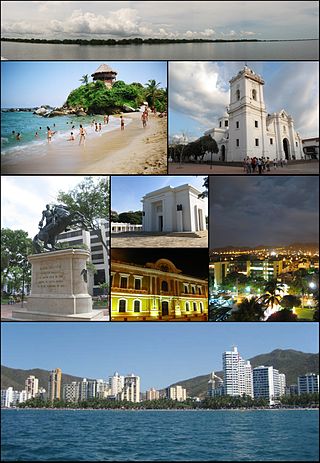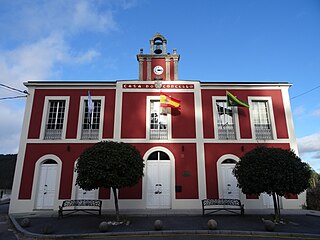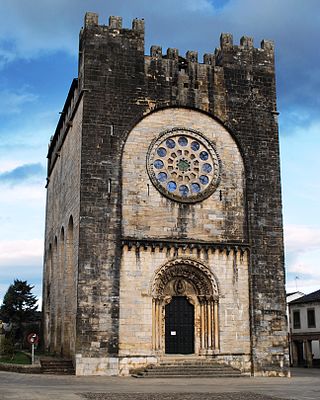
Santa Marta, officially the Distrito Turístico, Cultural e Histórico de Santa Marta, is a port city on the coast of the Caribbean Sea in northern Colombia. It is the capital of Magdalena Department and the fourth-largest urban city of the Caribbean Region of Colombia, after Barranquilla, Cartagena, and Soledad. Founded on July 29, 1525, by the Spanish conqueror Rodrigo de Bastidas, it was one of the first Spanish settlements in Colombia, its oldest surviving city, and second oldest in South America. This city is situated on a bay by the same name and as such, it is a prime tourist destination in the Caribbean region.

Lugo is a city in northwestern Spain in the autonomous community of Galicia. It is the capital of the province of Lugo. The municipality had a population of 100,060 in 2024, making it the fourth most populous city in Galicia.
Adelantado was a title held by some Spanish nobles in service of their respective kings during the Middle Ages. It was later used as a military title held by some Spanish conquistadores of the 15th, 16th and 17th centuries.

Alonso Fernández de Lugo was a Spanish conquistador, city founder, and administrator. He conquered the islands of La Palma (1492–1493) and Tenerife (1494–1496) for the Castilian Crown; they were the last of the Canary Islands to be conquered by Europeans. He was also the founder of the towns of San Cristóbal de La Laguna, Santa Cruz de Tenerife and Santa Cruz de La Palma. One biographer has written that his personality was a “terrible mixture of cruelty and ambition or greed, on one part, and on the other a great capacity and sense for imposing order and government on conquered lands,” a trait found in the conquistadors of the New World.

Benavente is a town and municipality in the north of the province of Zamora, in the autonomous community Castile and León of Spain. It has about 20,000 inhabitants.

The Diocese of Mondoñedo-Ferrol is a Latin diocese of the Catholic Church in Spain. It is the northernmost of the four suffragan dioceses in the ecclesiastical province of the Metropolitan Archdiocese of Santiago de Compostela, which covers Galicia in the northwest of Spain. The area had previously been home to Britonia, a settlement founded by expatriate Britons in the wake of the Anglo-Saxon invasion of Britain. Britonia was represented by the diocese referred to as Britonensis ecclesia in sources from the 6th and 7th centuries.

Baralla is a municipality in the province of Lugo, in the autonomous community of Galicia, Spain. It belongs to the comarca of Os Ancares and covers 30 villages. Until the late 1970s it was called Neira of Jusá.

Castro de Rei, is a municipality in the province of Lugo, in the autonomous community of Galicia, Spain. It belongs to the comarca of Terra Chá. The population in 2009 was 5,685 people according to INE.

Xermade, is a municipality in the province of Lugo, in the autonomous community of Galicia, northwestern Spain. It belongs to the comarca of Terra Chá.

Samos is a municipality in the province of Lugo in the autonomous community of Galicia, Spain. It belongs to the comarca of Sarria.

Ourol is a municipality in the province of Lugo, in the autonomous community of Galicia, Spain. It belongs to the comarca of A Mariña Occidental.

Guntín is a municipality in the province of Lugo, in the autonomous community of Galicia, Spain. It belongs to the comarca of Lugo.

Lourenzá is a municipality in the province of Lugo, in the autonomous community of Galicia in northwestern Spain.

Vilasantar is a municipality of northwestern Spain in the province of A Coruña in the autonomous community of Galicia. It belongs to the comarca of Betanzos.

O Páramo is a municipality in the province of Lugo, in the autonomous community of Galicia, Spain. It belongs to the comarca of Sarria. It has a population of 1632 persons and an area of 74.92 km2.

Portomarín is a municipality in the province Lugo, in the autonomous community of Galicia, Spain. It belongs to the comarca of Lugo. The town has a population of 1345 and an area of 115 km². It is one of the towns in the pilgrimage route known as the French Way, part of the Camino de Santiago.

A Pastoriza is a municipality in the province of Lugo, in the autonomous community of Galicia, Spain. It belongs to the comarca of Terra Chá. It has a population of 3,911 and an area of 175 km². The most important river in Galicia and one of the most plentiful rivers of Spain begins here, the Miño River.
La Algaba is a Spanish municipality in the province of Seville, Andalusia, with a population of around 16,000. It is part of the region of La Vega and is located 11 km from the province's capital, Seville. The town dates back to the Byzantine Empire and has many historical artifacts and significant churches.
Juan (Francisco) de Céspedes Ruiz was a Spanish conquistador who is known as the founder of the town of Pasca, Cundinamarca, in the south of the Bogotá savanna, Colombia. De Céspedes arrived in the Americas in 1521 and participated in the conquest of the Tairona and the foundation of Santa Marta under Rodrigo de Bastidas. From 1542 to 1543 and in 1546 he served as mayor of Bogotá and after that until 1570 as lieutenant general of the first president of Colombia. Juan de Céspedes married Isabel Romero, one of the first Spanish women who arrived at Colombian territories and had two legitimate sons and one daughter. His date of death is uncertain; in late 1573 or 1576.

Solomon Islands–Spain relations are the bilateral and diplomatic relations between these two countries. Solomon Islands does not have an embassy resident in Spain but maintains an honorary consulate in Madrid. Spain has an honorary consulate in Solomon Islands.



















